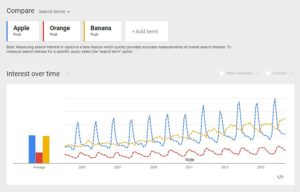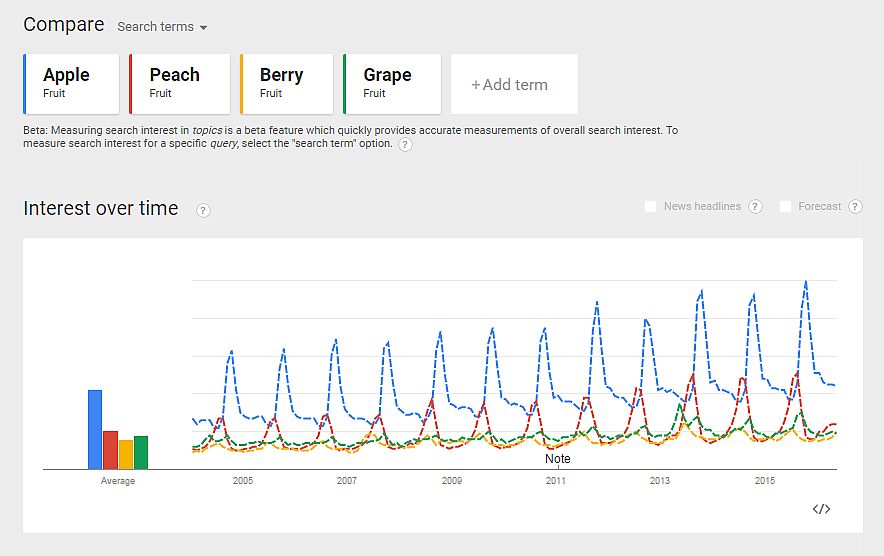What Do Consumers Want To Know About Fruit?
Google Trends can give farm marketers a great deal of insight into what consumers are interested in. The way the program works is you type in search terms you’d like to learn more about. You’ll then learn the ebbs and flows of how often the term was searched over time, geographic areas where it was searched, and related terms.
You can also compare terms. For example, take a look at the search patterns for the three most common fruits, apples, oranges, and bananas:
Apples have a slightly higher search volume than bananas, but the search patterns are much more volatile. That’s likely due to the fact that apples are primarily U.S. crops, and so interest in them is more closely tied to harvest seasons, whereas bananas are an import. (I should note that “apple” here refers to only the fruit, not the tech company — the program allows you to specific to that level.)
So let’s take a look at the more common U.S. fruit crops: apples, peaches, berries, and grapes.
As you see, all these crops tend to peak during harvest times. Since these are consumer searches, the interest around harvest times likely indicates a desire to attend festivals or visit orchards and farms.
Another piece of information you can glean from this chart is changes in interest over time. All the crops’ search terms are seeing an increase in internet traffic. Berry has a lower overall increase, but that changes if you compare specific berries. Consumers are more likely to search for “strawberry” or “blueberry” than “berry” on its own. In fact, “strawberry” is a much stronger rival to “apple” than any of the fruit terms above.
Another feature you can find in Google Trends is the geographic feedback. It defaults to the world, but you can narrow it down to the U.S., or individual states, and even down to regions within each state.
Here’s what the map for the search term “apple” looks like:
This map is an aggregate of searches since 2004, and those in the Midwest and Northeast were the most likely to search for “apple” — prime locations for farm markets located on apple orchards.
Let’s compare this to the map for “peach”:
In contrast to the map for “apple” as a search term, this one for “peach” shows that specific states are more likely to show high searches as opposed to to entire regions. Here, those in Georgia are not surprisingly the most interested in peaches. Utah follows in second place.
The final section in Google Trends you can gain insight from is the related search terms section.
This section is divided into two sections, “topics” and “queries.” Topics are the broader categories of searches, where as queries looks at specific phrasing.
For example, the topics related to “apple” includes Apple (the tech company), calories and nutrients, and orchards and literature subjects.
Queries for apple are “apple,” “apples,” “calories apple,” and “apple tree.”
From the more extended lists for both topics and queries, you can infer that consumers are concerned about the calories in apples and are looking for apple recipes.
When you get the chance, take some time playing with Google Trends and see what you can learn about what consumers thing about your own crops.











